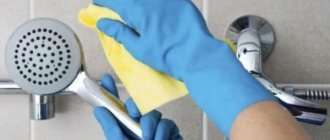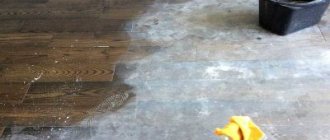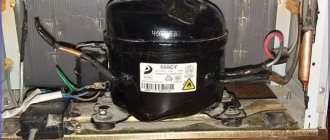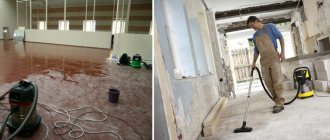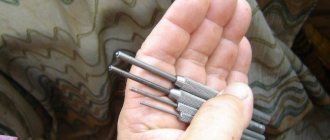It's hard to imagine a bathroom without a shower. One of the main conditions for comfortable water procedures is the proper functioning of the plumbing. However, the water in the city is hard - often a deposit of mineral elements appears on the surface of plumbing equipment. But this is not a reason to throw away part of the headset. You need to figure out how to take your shower head apart and fix it.
Step-by-step disassembly instructions
To work, you will need a Phillips screwdriver, an adjustable or gas wrench No. 1, and a special pin wrench for disassembling the shower head.
Often this key comes in a set. If you don’t have one, you can make it yourself or use improvised items. When disassembling the shower body yourself, it is recommended to be extremely careful and put small parts and structural elements aside separately. When dismantling rubber gaskets, they must be handled with extreme care to avoid damage. Do not forget about the presence of a spring in the housing.
So, the algorithm is as follows:
Turning off the shower, removing the shower head from the flexible hose. This is done quite simply: unscrew the nut at the junction with the hose. Before doing this, you must turn off the shower mode on the mixer. In order to disassemble the watering can with the switch, you need a special key. If you look closely at the diffuser mesh panel, you will see 3-5 recesses on the central circle intended for dismantling. The panel unscrews from right to left. You can unscrew the central panel of the shower screen with a special key; if it is not available, you can use scissors with rounded ends for this purpose. But it is best to use a key, this will keep the surface of the mesh intact, without scratches or defects. After removing the central panel, you can see the swirl box underneath, which is secured in the center with a screw. Unscrew it with a Phillips screwdriver. Remove the concentric circles of the shower screen, switch
Pay special attention to the movable diffusers and flow diffusion baffles that may be located under the diffuser. When opening the mesh, they must be carefully removed
Then remove the swirler from the watering can. Pay attention to the rubber gaskets; they must be handled very carefully. Below the swirl ring is usually the switch spring. Removing the case must be done carefully to avoid its loss. The swirl box can be one-piece, not subject to repair, or detachable, with 2-3 plastic latches; in this case, opening the box is not recommended. The latches are quite weak and may not withstand brute force. Screw connections are less common.
Assembly after repair or replacement of parts is carried out in the reverse order: the swirl body is inserted, the screw is tightened, concentric mesh diffusers are installed, and the central panel is tightened. After which the watering can is connected to a flexible hose.
After disassembly, be sure to rinse the inside of the holes in the mesh; usually, during use of the shower, so-called water stone forms in them - a deposit of mineral elements and rust found in tap water.
How nice it is to come home after a hard day at work and take a relaxing shower. However, sometimes situations arise when the shower head stops functioning, thereby depriving us of well-deserved pleasure. Don’t despair, because you can fix the problem yourself, and you won’t have to spend a lot of time. Let's figure out how to disassemble the shower head in the bathroom yourself, and what features should be taken into account.
Types of breakdowns
Due to the simple design of the product, there are few types of breakdowns. Most often, the inner rubber tube is the first to fail - over time it dries out, crumbles and bursts in places where there are frequent bends. Connecting fittings break less often - under the influence of impacts and other mechanical damage, union nuts crack or their rubber seals become unusable.
The third type of failure occurs when the outer protective sleeve is torn or broken. In the first two cases, it is still possible to repair the product, but in the last option, only a complete replacement of the braid or the entire hose is necessary.
How is the installation done?
The shower cabin comes with an instruction manual describing how it works. If it is not there, then installation should be carried out based on the following tips:
- You should select a location for assembly. It is advisable not to do this in the bathroom.
- Installation of the pallet depends on whether there is a frame. If it is present, then fixation will be more difficult.
- It is necessary to turn the pallet over and fix the square beams to it.
- The beams have holes into which the studs are installed. The long side rests against the corner of the product, and the short side against the floor.
- On one side the fixation is carried out with a nut, and on the other - with a thrust bearing. The structure must be turned over and put in place. The height is adjusted using the thrust bearing.
- After installation, everything is tightened using locknuts. To fix the pallet to the wall, you must use brackets. The joints are coated with sealant.
Installation of a product without a frame is carried out as follows:
- When installing a product with a flat tray, a siphon should be installed. You should unscrew the clamp and the joint with the drain hole, and treat it with sealant.
- Then everything is inserted into place.
- On the other side, a sealant treated with silicone is attached to the corrugation.
- Then the hose is inserted into the sewer.
- After installing the siphon, you need to pour water into the pan and check for leaks. If absent, then major fixation is performed.
- The product is attached to the installation site and raised by 5 cm. Polyurethane foam is poured under it. The load must be placed in the installed pallet. Only after a day can you perform the next stage.
Adviсe
Changing the shower head in the bathroom is not difficult at all if you follow the tips described above. It can also be opened to remove limescale from the inside, or painted if necessary. A cracked handle can also be easily replaced or repaired.
Cleaning a clogged shower head is a procedure that requires time and attention, although it is not difficult. With a small set of tools and products for getting rid of dirt, you can achieve the desired result yourself and without the need to call professionals.
To learn how to properly disassemble a shower head with a switch, see the following video.
Variety of shapes and sizes of shower heads
Modern nozzles can vary in shape and size. Shower heads are produced in the following shapes:
- rectangular and square;
- triangular;
- round and oval.
The size of the watering can is determined by its area of application. For example, those who like to bring down a whole “waterfall” on themselves choose “tropical rain” models, the working area of which is about 50 cm2. Connoisseurs of the classics choose standard manual watering cans, the diameter of which does not exceed 6-8 cm.
The ergonomics of the product is also important. Therefore, when choosing a model, twirl it in your hands to check how convenient it will be in everyday life.
Some stores have a special stand where the consumer can check the functionality of the device by placing his palm under the stream
In terms of practicality, those watering cans in which modes are switched using a button are much more convenient. It's much safer for your hands. And besides, rotary mechanisms are beginning to become a thing of the past.
Characteristics of modes
The use of innovative technologies has helped the company become a leader in the production of sanitary ware. The product line of the manufacturer from Germany includes 40 models. The main competitive advantage of the company is the versatility of its products.
For example, the connecting thread is compatible with all types and types of hoses.
A distinctive feature of the plumbing of this oldest company in the world is also the versatility of the devices produced. Some brand models have 5 jet modes:
Normal – energetic pressure. Ideal for morning routines.
Jet – high-speed flow with a massage effect.
Rain – imitation of tropical rain.
Massage – pulsating vortex mode to relieve tension.
Champagne is an ozonized lightweight stream designed for relaxation.
Choosing a shower head
Depending on the installation method, shower heads are either stationary or with a flexible shower hose. Stationary ones can be ceiling or wall mounted. Shower heads with flexible hoses are available in two wall mounting designs. Using a headset (the bracket in which the shower head is installed is mounted on a fixed vertical rod and can be moved in height) and using a bracket permanently fixed to the wall.
Both mounting designs allow you to rotate the watering can around its axis and change the angle of inclination, which makes it possible to direct streams of water in the desired direction. The design of the shower head fastening allows you to quickly remove it from the bracket for manual use. This may be necessary, for example, when washing a child or a person with limited mobility, washing a bathtub and tiled walls near the bathtub or the walls of a shower stall.
There are designs where the shower head is not mounted on the wall, but simply lies on the mixer in a special plug. It is inconvenient to use such a watering can when taking water procedures, since one hand is occupied.
Stationary wall and ceiling shower heads are non-removable, the water supply tube is usually hidden in the wall, and the water mixer is installed on the wall, in a place convenient for turning on the supply and adjusting the water pressure. Wall-mounted watering cans usually provide for adjusting the direction of the water jets. In ceiling-mounted systems, this option is available only in very expensive models. The advantage of ceiling showers is the imitation of real rain, thanks to the large area of flow of water jets. Ceiling-mounted shower heads are typically made of chrome-plated brass, require more water pressure in the plumbing, and are very expensive.
Wall-mounted stationary shower heads, as in the photographs, are also usually made of chrome-plated brass, but they cost much less than ceiling ones. Stationary ones also have the ability to control the direction of the water jet.
If there is a need to wash a child, people with limited mobility or animals, then it is better to refrain from installing a ceiling or wall watering can, or in addition install a watering can with a flexible hose. The photo shows a wall-mounted shower head and an additional one with a flexible hose. The water supply to the watering cans is controlled from one lever mixer tap. Using the button, you can switch the water supply to any of them in turn.
The choice of a shower head with a bracket on a rod is justified only if there are people in the family with a large height range, although the flow of falling jets from any water dispenser of the water head does not expand much towards the bottom, and people of short stature should not experience discomfort when taking a shower. Unless it will be difficult for them, if necessary, to reach the watering can to pick it up. Some people simply like the look of the shower head on a rod design. But this pleasure costs several times more than a shower head with a simple bracket. It should also be noted that if the fixing handles are made of plastic, they will wear out over time.
When choosing a shower head, you need to pay attention to the water divider. There are two types of dividers in shower heads: in the form of a flat plate made of metal or plastic with holes, and in the form of a curved surface, in which not just holes are made, but for each jet a rubber nozzle, which is a short tube, is installed separately
Thanks to the nozzles, the shape of the column of water flowing from the watering can is shaped in such a way that when the water pressure is weak, the jets do not combine. Due to the elasticity of the rubber, the holes in the divider, unlike flat dividers, will not become clogged with limescale. Only large particles of dirt can clog the holes.
Modern shower heads are usually made of plastic. This reduces the cost, the watering can is lightweight and does not damage the enamel coating if it falls into the bathtub. Thanks to the metallized coating, the body of the watering can has a beautiful appearance.
Taking into account the above, a budget option for purchasing a shower head is a plastic shower head with a rubber divider, a flexible shower hose mounted in a bracket on the wall.
Availability of additional functions
Modern shower heads have long ceased to be just sprayers.
To increase the level of comfort during water procedures, these elements are often equipped with additional options. In an effort to increase the level of comfort and increase the functionality of the device, manufacturers do not cease to improve the design of watering cans
Additional features include:
- Changing the spray mode. This function allows you to independently adjust the pressure mode, creating rain or massage jets.
- Water saving. For this purpose, a valve is installed on the body of the device, which mixes air into the stream of water. This function allows you to save up to 60% water, depending on the mode.
- Mineralization. For this purpose, devices are equipped with mineral elements such as tourmaline, germanium or shungite. Water, passing through minerals, is dechlorinated and becomes softer.
- Backlight. The effect of light therapy is achieved due to the glow of LEDs built into the body.
- Turning off the water supply. This function is performed by a button that shuts off the water supply. The function is convenient because it eliminates the need to constantly monitor the water temperature, even if the shower spout is closed through the mixer.
Many people know about the ability of color to influence a person’s well-being. For example: green relaxes, red gives a boost of energy, and yellow tones and improves mood. Experts have developed a whole method of treatment with light of various spectrums. And leading manufacturers also did not miss this moment. Today you can find backlit models on sale.
To turn on the backlight, the device does not need to be powered by electricity; A small generator built into the middle of the device is responsible for this task.
The generator built into the body of the device is capable of generating energy from the water flow that occurs when the shower is turned on. You can fix such a watering can on a rod or stand.
In addition to their main purpose - stabilizing pH to neutral, watering cans with minerals reduce water hardness and remove chlorine from it
Watering cans with minerals are equipped with a multi-stage filter that softens and carefully purifies the water. The water coming out of the nozzle holes becomes aerated and ionized, and the bubbles running through the body give real bliss.
Cleaning products
To clean the head of a regular or more difficult to clean rain shower on your own, you can use:
- special chemicals;
- folk remedies.
Application of chemical compounds
How to clean a shower sprayer from limescale and scale deposits? The easiest way is to use household chemicals, which differ:
- speed of cleaning;
- absence of negative impact on the body and other structural elements;
- efficiency.
The most popular means are:
- Cillit Bang;
- Toilet duckling;
- Mister Muscle;
Lime remover
Cleaning of scale and lime using household chemicals must be carried out in accordance with the instructions indicated on the packaging and in compliance with all safety rules.
Folk remedies
How to clean the inside of a watering can in the absence of specialized products? You can use traditional methods, among which the following are popular:
- vinegar. To carry out the procedure, use 7% vinegar. The use of essence is prohibited, as it negatively affects the body of the plumbing fixture. Cleaning is done as follows:
- the solution is prepared;
- all elements of the watering can are immersed in the solution for 6 – 10 hours (can be left overnight);
The elements are washed with running water.
- lemon acid. Cleaning is carried out according to a similar scheme. For full effect, it is enough to soak the watering can in the solution (1 sachet of citric acid is required for 1 liter of water) for 2 – 3 hours;
Technology of using citric acid
- a solution of soda, ammonia and table vinegar. For 1 liter of water you will need 3 tablespoons of soda, 350 ml of 9% vinegar and 150 ml of ammonia. For quick effects, it is recommended to heat the prepared solution to 60°C. Cleaning time ranges from 40 minutes to 1 hour;
- oxalic acid. In extreme situations, with a high degree of contamination, cleaning can be done using a solution of oxalic acid, which is purchased at a pharmacy. To prepare the solution you will need 1 liter of water and 2 tablespoons of acid. Processing time is 20 – 60 minutes.
Aggressive cleaning agent
After complete removal of contaminants, reassemble in reverse order.
When assembling, it is important not to forget to install all the O-rings and, if necessary, seal the connections of the shower head with the shower hose
To ensure that cleaning of plumbing equipment does not take much time, it is recommended to carry it out once every 6–8 months (if filters are available) and once every 4–5 months if such equipment is not available.
Causes of clogging
The main reasons for a clogged shower head are:
- low quality of supplied water. Due to the quality of water, limescale deposits form on the body of plumbing equipment, which leads to a gradual reduction in the passage holes;
- the absence of filters in the water supply system that can retain particles of sand, rust and other pollutants at the entrance to the system.
Filtration of water before supply to plumbing
To reduce the frequency of shower head cleaning, it is recommended to install equipment made of copper or stainless steel. Plastic products are more susceptible to clogging with small particles, while steel products are more susceptible to corrosion.
Shower head disassembly technology
How to disassemble a shower head? This process is considered quite simple and understandable, so even without experience it will not be difficult to carry out the work. The procedure is divided into successive stages:
- the watering can is disconnected from the hose, and to do this it is enough to unscrew the element. If the product is new, then this process will not cause difficulties, but if it has been used for a long time, then usually a lot of scale and alkali have accumulated at the joint, so the process causes difficulties. It is often possible to unscrew the watering can only with a gas wrench;
- Direct disassembly of the element begins. There is a plug in its center. It should be dismantled, and it is quite easy to pry it off with an ordinary sharp knife. As a rule, there are no obstacles to removing it;
- After removing the plug, the screw will be revealed. It is this that holds the mesh, and it is quite difficult to unscrew it, since usually a lot of sediment accumulates here due to the use of low-quality water. First, the recess is cleaned with a blade, after which the screw is unscrewed;
- Then you can begin to disconnect the mesh from the body. This work is carried out carefully, since if you make sudden movements, the gasket can easily be damaged. Although this element has a low cost, the difficulty lies in finding the gasket of the right size and thickness.
First remove the plug
Under the plug there is a screw that needs to be unscrewed
Disassembled shower head
Thus, if you follow the instructions exactly, you will get a disassembled element consisting of several parts. After completing the process, it will be easy to clean them from dirt and blockages.
Cleaning
Various methods can be used to clean a shower head, and you can use all methods at once to achieve the best result. Solutions used for these purposes:
- using vinegar - for this process you need to prepare a regular container with 9 percent vinegar. The amount of solution depends entirely on the diameter of the mesh, and the most common designs are with a diameter of 5 or 6 cm. Therefore, 300 g of vinegar is used. The solution is poured into a container, where the mesh and other parts of the structure are then lowered. It is advisable to keep them in vinegar overnight;
- the use of citric acid - this method is considered more efficient, since this product quickly copes with various blockages. To do this, it is also necessary to lower the mesh into a container with citric acid, and then boiling water is poured, and the part should be completely hidden in the solution. You need to wait for the water to cool, so it will take about 20 minutes. Next, bubbles will begin to appear, after which the mesh will be pulled out. It is cleaned quite easily and quickly after this procedure with a standard toothbrush. This is due to the fact that the plaque softens, so it is easily detached from the mesh.
To clean a shower head, you can use vinegar or citric acid.
Thus, cleaning a shower head is a simple process that involves using standard solutions found in almost every home.
Assembly
Assembly is performed in exactly the same way as disassembly, only in reverse order. To do this, the mesh is placed in the housing and then secured with a screw.
Thus, cleaning the watering can is easy if you figure out how to disassemble and reassemble it. If the room has a switch from the shower to the tap, then often problems with the flow of water are associated with it, so repair work has to be carried out.
Replacement
The complexity of the repair will depend on the type of breakdown of the product, the design and installation method of the mixer itself. If it is mounted into the wall for a more aesthetic appearance, the process of dismantling the hose will become more complicated. But in any case, when carrying out work you will need the following tools:
Also, if the old product is being repaired rather than replaced, plumbing fum tape may be required. It is necessary to seal the seats where the fastening nuts are connected to the shower head and mixer.
After prolonged use, the threads in these places gradually deteriorate, and in addition, the union nuts themselves become loose. Therefore, to prevent leaks, it will be necessary to additionally seal the joints.
Dismantling
Before dismantling work, you first need to turn off the water. It is recommended to close not only the faucet valves, but also the central shut-off valve under the sink. Only after this can you begin to remove the broken hose. First, you need to dismantle the shower head - hold it with one hand, and with the other unscrew the union nut, rotating it counterclockwise.
From time of use or under the influence of salts contained in the water, the threads of both elements can stick to each other. To make the procedure easier, you need to wipe the surface of the nut dry and wrap it in a thick rag . As a last resort, you can use pliers, but it is also recommended to place a rag under their jaws, otherwise the shiny surface of the fastener will be scratched.
In the same way, the nut securing the hose to the threaded tube of the mixer is unscrewed. At the point where the hose is attached to the mixer, the union nut is usually tightened more tightly than on the watering can.
In addition, in most types of products it has a hexagonal shape, which also makes it difficult to dismantle it with bare hands. Therefore, here it is unscrewed with an adjustable wrench or pliers, also pre-wrapped in a rag or napkin; for convenience, you can wrap electrical tape around it. You should not squeeze the nut too hard; you need to work carefully and control the pressure. In some cases, the thread gets stuck and cannot be unscrewed even with tools, then it is recommended to use any composition to remove rust - solvent, acetone or a special WD-40 product.
Repair
Before starting repair work, you will need to establish the cause of the breakdown - inspect the hose and determine the place where it broke or leaked. If there is a rupture or a crack in the inner rubber tube, then water begins to flow through the outer shell, practically not entering the watering can sprayer. In this case, it is necessary to remove the tube and shorten it to the point of rupture. To disassemble and remove the outer shell, you will need to move the fastening nut and try to pry the inner sleeve of the rubber tube with a sharp object (knife), and then pull it out of the braid.
The tube is then inserted back into the braid and secured with the same metal sleeve. The bushing may fit tightly into the newly formed cut area, since the rubber is not developed here, so it is recommended to first clean it of limescale and moisten it with water. After this procedure, the inner tube will become shorter, and the metal shell will remain the same length, this will make the hose more rigid, but the problem of breakdown will be solved without the need to purchase a new product.
However, it is worth noting that such a repair is only possible if a crack in the rubber has formed close to the seat.
If the inner tube bursts in the middle of the hose, there is no point in shortening it, since the outer casing does not require cutting - only a complete replacement of the hose will be required.
When damage or stretching of the protective braid occurs, the repair process involves similar actions:
- unscrew the union nuts;
- remove the mounting sleeve;
- remove the rubber tube;
- insert it into a new shell;
- clean and reinstall the bushing.
If the union nuts are damaged, it is necessary to dismantle the inner metal sleeve in the same way, remove the broken nut and replace it with a new element.
Leaks often occur due to failure of rubber seals (gaskets). They are installed inside the union nut where the sleeve meets the end of the shower head or faucet. This is the simplest type of repair - you just need to unscrew the nut and replace the worn gasket with a new similar part. The latter can be purchased at the store or cut yourself from a piece of rubber of the same density and thickness.
Dismantling sequence
Disassembling a divider of a conventional design begins with unscrewing the union nut, through which the water supply hose is attached to it. In a situation where the watering can has not been in use for very long, this nut can be unscrewed manually. If, due to strong “sticking” of the joint, this was not possible, you will have to use an adjustable wrench.
After removing the nut, you will need to disconnect the supply hose and begin disassembly.
In order to disassemble a shower head with a switch (from Grohe, for example), you will need a special key, instructions for use of which are given below.
First of all, in the center of the scattering mesh you should find several recesses designed specifically for its dismantling. Having inserted the key into them, you need to turn it counterclockwise until this part is completely turned out.
After unscrewing and removing the central panel, the swirl box is removed from under it, which is fixed in the center with a special screw. To dismantle it you will need a Phillips screwdriver. After this, free access to all parts to be cleaned will be provided.
https://youtube.com/watch?v=oEAewZyJV7s
Required Tools
It is necessary to disassemble this structure with suitable tools, and they are usually available in every home. These include:
- regular screwdriver;
- thin and sharp knife;
- crosshead screwdriver;
- molecular glue.
If you have a fairly complex model, it may require a special three-pin wrench to ensure optimal dismantling of the case. As a rule, such models are sold complete with this tool, so there is no need to purchase it separately.
Watering can device with switch
This watering can is usually a body made of hard plastic, inside of which there is a round-shaped structure equipped with several concentric flow swirlers. Moreover, each of them works for its own regime. The swirlers are installed in the housing according to the “matryoshka” principle and, with rare exceptions, are united by a common housing.
The flow force can increase or decrease depending on the diameter of the swirler and the cross-section of the chamber openings. This achieves different pressures of the water flow at the outlet of the chamber.
On the outside, the water supply chamber is covered with a mesh, which also influences the formation of the stream: for example, intermittent or with the addition of air bubbles. This is achieved by using various kinds of artificial barriers and movable flow dividers.
The mode switching mechanism itself is installed on the outer circumference of the watering can; as a rule, it is multi-sectional. Its task is to open one or two chambers of the swirler, blocking the rest. This achieves switching modes and combining them if necessary.
Cleaning and reassembly
The procedure for cleaning a disassembled shower head includes the obligatory washing of the dissecting mesh, on which so-called water stone or scale accumulates during the operation of the shower. Experts advise using special cleaning compounds for this purpose, which are freely available for sale. Acid and products like Santry clean scale well.
After disassembling the divider, its elements on which large accumulations of stone are noticed are washed. Upon completion of these procedures, the previously dismantled and cleaned product is assembled in the reverse order of its disassembly.
When dismantling the shower head for cleaning, you should also check the condition of its other components (mode switch or sealing gasket on the coupling). If any violations are detected in their condition, these elements are either restored or replaced with new ones.
How to clean a drain
Before removing the siphon and cleaning it, it is recommended to remove any remaining water from the shower tray.
Disassemble the siphon and clean it from blockages
To repair a structure, it must be cleaned. Cleaning steps:
- Place some container into which the water will flow, for example, a basin or bucket.
- Remove the closure nut and then the flask. Wait until all the water has drained from the water seal.
- Clean to remove all dirt and debris. Rinse everything thoroughly with water, completely remove all plaque on the walls.
- Put it in place, making sure that the drain pipe does not press against the flask. Tighten all connections tightly.
- Turn on the water and check the connections. If they are dry and the water drains freely, then everything is done correctly.
Photo 1. Disassembling and cleaning the shower siphon will not be easy, since it is located in a hard-to-reach place - under the bottom of the cabin.
It is recommended to clean the siphon not only because of a blockage, but also for prevention, once every 3 to 4 months.
Clean with a plunger
Another way to clear a clogged shower stall is to clean it with a plunger. Procedure:
- Take a plunger and coat it with Vaseline.
- Fill the shower tray so that the water completely covers the rubber part of the plunger.
- Place the plunger on the drain so that the rubber part is tightly covered.
- Make 20-30 movements up and down, remove the plunger and check if the water leaves. If not, then carry out the procedure again.
- If water begins to drain, rinse the drain with hot water.
Using a plumbing cable
If the blockage has formed deep in the pipe or the contamination has become very compacted, a plumbing cable will help eliminate the problem.
But it is recommended to use it only if the drain in the shower stall is made of metal pipes and not plastic.
Procedure:
- Insert the cable into the drain hole. In this case it is necessary to rotate it.
- Push it back and forth with sharp movements about 15-20 times.
- Rinse with hot water.
- Remove the cable along with any debris that is attached to it.
Using household chemicals
Experts do not recommend cleaning the shower drain using household chemicals, but sometimes this becomes the only available option. In this case, you need to carefully and meticulously study the composition of the drain cleaner, and choose a powder, liquid or gel that is suitable specifically for the drain in the shower stall.
Important! It is prohibited to use toilet blockage removers to clear the drain in the shower stall. Most often, the products contain aggressive substances that can not only dissolve debris, but also corrode the rubber parts in the drain and damage the acrylic pan
Having chosen the appropriate product, you must carefully study the instructions for use and follow them. Usually the process of removing the blockage is simple:
- Pour the product into the drain.
- Wait for the specified time specified in the instructions for use. The chemicals contained in the product corrode debris, hair, grease, and soap residue, after which the water begins to drain freely.
- Rinse the drain with a strong stream of hot water.
When using household chemicals, you must use rubber gloves. And also do not forget that some household chemicals can form harmful fumes.
Hose repair
An equally common cause of breakdown is the failure of the hose that supplies the watering can with water. It breaks for two reasons:
- water begins to flow at the junction of the watering can with the hose;
- the corrugated shell is damaged, which causes leaks to form on the product body.
Fixing the problem is not difficult, the main thing is not to be afraid and act according to the instructions.
Repairing leaks
Leaks occur at the hose connections. This happens due to wear and tear of the rubber gasket, which loses its elasticity over time. It all starts with small leaks that are practically not visible to the human eye.
Subsequently, the leak becomes larger and larger, making the shower impossible to operate.
If a problem like this occurs, you should do the following:
- we try to tighten the fixing nut more tightly to ensure a tighter fit of the gasket;
- if the problem persists, most likely the gasket will have to be changed;
- however, replacing the gasket also does not always help eliminate the problem. In this case, pay attention to the nipple inserted into a plastic pipe of larger diameter;
- remove it and inspect the part for cracks. If they are found, we cut the nipple to workable sizes or replace it with a new one.
Note! If a crack is found in the plastic tube itself, it can be heated or cut. Be careful when heating. As soon as the crack is sealed, turn off the heating.
Brass Corrugated Shell Repair
If the hose is strongly twisted during shower procedures, the coils of the brass corrugated shell may not withstand it and may separate. In this case, the tightness of the hose is broken, which will lead to damage to the plastic part.
Fixing the problem is simple:
- grab the hose with both hands near the rupture site;
- We begin to turn the upper hand clockwise, trying at the same time to pick up the upper turn of the shell with the lower one.
When performing repair work, it is important to observe two conditions:
- you need to twist the hose carefully, without using excessive force;
- do not forget to monitor changes in the diameter of the braid. Try to rotate the braid so that entire segments are not subjected to unnecessary stress.
If the hose cannot be repaired once assembled, you can remove the union nut and then twist the casing. Otherwise, there should be no problems with the repair.

